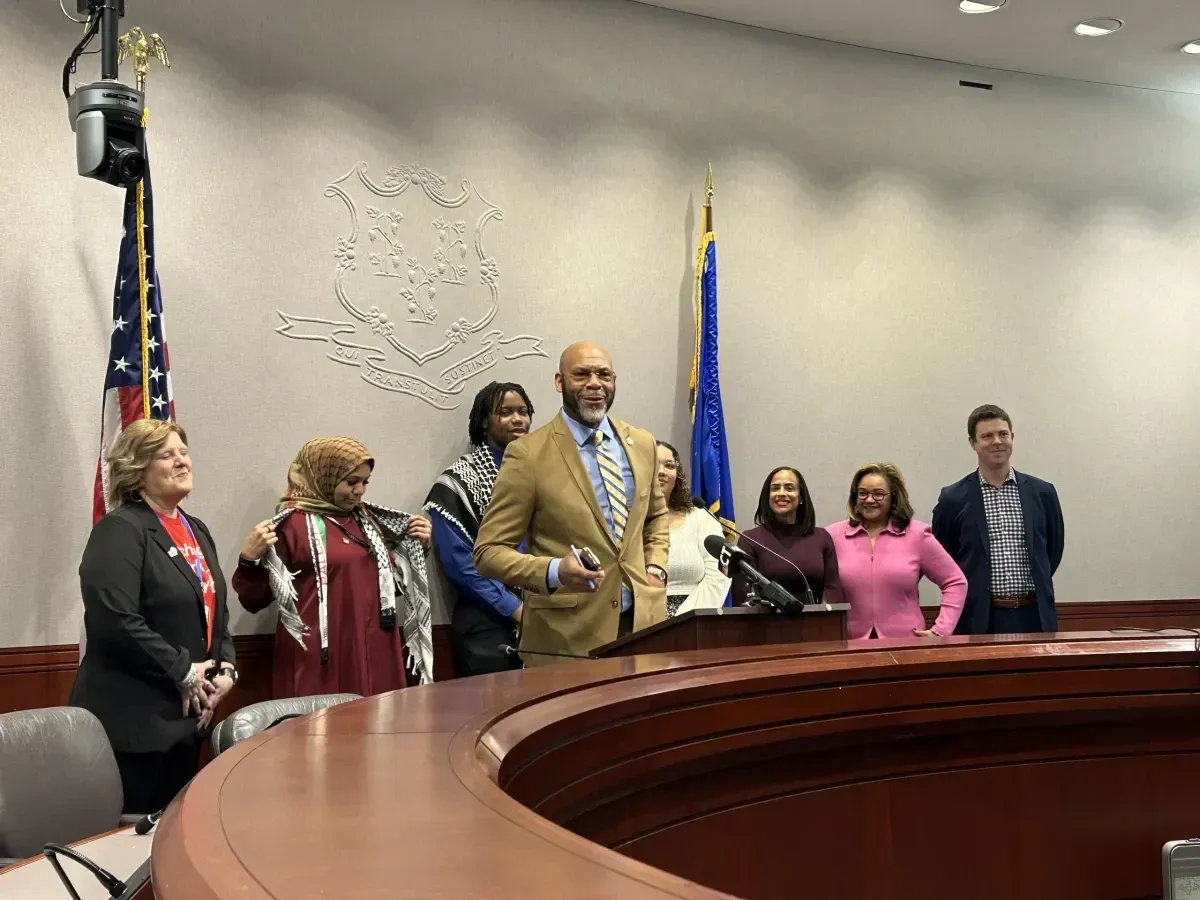CT bills would fight teacher shortage by changing pay, certification

Sen. Doug McCrory, D-Hartford, urged students to apply for the Aspiring Educators Diversity Scholarship Program
Jessica Harkay/CT Mirror

Sen. Doug McCrory, D-Hartford, urged students to apply for the Aspiring Educators Diversity Scholarship Program
Legislation passed out of the Education Committee last week would raise starting salaries for educators and make it easier to obtain teacher certification, measures that some lawmakers hope will address teacher shortages and aid ongoing efforts to recruit and retain a diverse teacher workforce in Connecticut.
Language in Senate Bill 381 and House Bill 5348 proposes using state subsidies to raise the starting salary for educators up to $60,000 and to $45,000 for paraeducators, respectively.
But the bills could face an uphill battle due to their cost at a time when Gov. Ned Lamont and legislative leaders are hesitant to step outside the state’s so-called fiscal guardrails and others, like social service agencies and higher education institutions, are also competing for more state funding. State subsidies, through the Office of Policy and Management, would be responsible for compensating school districts for the costs of the higher salaries, according to language in the bills.
“The situation we have here is systemic. It has been in place for a long time, and we could have done a lot more about this but we have sat on hands and knees and did nothing,” said Sen. Doug McCrory, co-chair of the Education Committee. “Research shows us that we have barriers in place that have made it very difficult to diversify this teaching population.”
Salary increases
TEACH Connecticut, a nonprofit that’s partnered with the state education department to recruit more educators into the field, reported that the average starting salary for teachers is around $43,000 — a key issue in terms of recruitment, retention and diversity, stakeholders said.
“Education is a workforce, and we’re in competition with a lot of other spaces to get people to come into our classrooms and teach,” said Kate Dias, the president of the Connecticut Education Association, the largest teachers union in the state. “We have to recognize that the same person who is in college considering ‘Do I want to be an actuary, an engineer or a math teacher?’ … [gets] to look at the compensation differences.”
Math teachers don’t expect to make the same amount of money as an engineer, Dias said.
“We’re not fools,” she said, adding that if education wants to remain on par with competing workforces, the range needs to be closer.
“I can’t be saying I’m gonna start at $42,000 as an educator, where I now have to live with my parents or I have to get three roommates or I could start as an engineer at $65,000 and be contemplating a complete different lifestyle,” Dias said.
Dias said a $60,000 starting salary, as proposed in SB 381, could also address an issue regarding “the pathway to the maximum” earning range, which has often been a reason teachers leave low-paying districts or the field completely.
Provisions in HB 5348 addressed a handful of issues pertaining to paraeducators, including formally defining the job and its responsibilities and raising the starting salary to $45,000.
Paraeducators in Connecticut currently make, on average, between $16.25 to $23.32 an hour, or around $33,000 to $48,000, according to ZipRecruiter.
Certification
The biggest concern with changes to teacher certification was the question of whether a streamlined process would come at the expense of quality.
Lawmakers and Education Commissioner Charlene Russell-Tucker say no, and have clarified that existing legislation was severely outdated and changes are long overdue after remaining essentially untouched for nearly 30 years.
The legislation includes changes to the three-tiered system of certification, where it would essentially eliminate a tier.
Currently, teachers must obtain their initial certification, which is valid for three years, then obtain a provisional certificate that’s valid for eight years.
Teachers can apply for their professional certificate after the provisional certificate and after “30 school months of successful appropriate experience in a Connecticut public or approved nonpublic school under the provisional educator certificate” and additional course requirements, according to the state Department of Education.
The proposed legislation would now allow a teacher to qualify for professional status if they hold an initial or provisional certificate and have completed at least 50 school months of teaching, completed a teacher education and mentoring program and either hold a master’s degree in the subject or completed an alternative pathway approved by the state.
Other changes would allow elementary school teachers to teach more than first through sixth grade.
“With this bill passed by the Education Committee, we are well on our way to implementing additional pathways and flexibility to help these educators begin to put an end to the teaching shortage Connecticut has been suffering for years,” said Daniel Pearson, executive director of Educators for Excellence-Connecticut, a nonprofit policy organization.
Full story on ctmirror.org
Sharon Center School
SHARON — A Sharon Center School staff member discovered a “facsimile firearm” behind a file cabinet around 2 p.m. Wednesday, Dec. 10, prompting an immediate response from State Police and a same-day notification to parents, according to police officials and an email obtained by The Lakeville Journal.
Melony Brady-Shanley, the Region One Superintendent, wrote in the email that, upon the item’s discovery, “The State Police were immediately notified and responded to the building.”
A canine team was brought in to sweep the building to confirm no additional items were present, “and the building has been fully cleared. The State Police consider this an isolated incident and not criminal in nature,” Brady-Shanley wrote.
State Police explained, “Troopers from Troop B - North Canaan were dispatched to the Sharon Center School for reports of a firearm located in a closet. The firearm was determined to be a non-firing, replica firearm... There was no threat to the school or the public.”
Brady-Shanley emphasized in the e-mail that “the safety and well-being of our students and staff remain our highest priority at all times. We will continue to follow and strengthen our safety protocols to ensure that our schools remain secure, supportive environments for learning.”
The Stone Round Barn at Hancock Shaker Village.
My husband Tom, our friend Jim Jasper and I spent the day at Hancock Shaker Village in Pittsfield, Massachusetts. A cold, blustery wind shook the limbs of an ancient apple tree still clinging to golden fruit. Spitting sleet drove us inside for warmth, and the lusty smells of manure from the goats, sheep, pigs and chickens in the Stone Round Barn filled our senses. We traveled back in time down sparse hallways lined with endless peg racks. The winter light was slightly crooked through the panes of old glass. The quiet life of the Shakers is preserved simply.

Originally founded in England, the Shakers brought their communal religious society to the New World 250 years ago. They sought the perfection of heaven on earth through their values of equality and pacifism. They followed strict protocols of behavior and belief. They were celibate and never married, yet they loved singing and ecstatic dancing, or “shaking,” and often adopted orphans. To achieve their millennialist goal of transcendental rapture, we learned, even their bedclothes had to conform: One must sleep in a bed painted deep green with blue and white coverings.
Shakers believed in gender and racial equality and anointed their visionary founding leader, Mother Ann Lee, an illiterate yet wise woman, as the Second Coming. They embraced sustainability and created practical designs of great utility and beauty, such as the mail-order seed packet, the wood stove, the circular saw, the metal pen, the flat broom and wooden clothespins.
Burning coal smelled acrid as the blacksmith fired up his stove to heat the metal rod he was transforming into a hook. Hammer on anvil is an ancient sound. My husband has blacksmithing skills and once made the strap hinges and thumb latches for a friend’s home.
Shaker chairs and rockers are still made today in the woodworker’s shop. They are well made and functional, with woven cloth or rush seats. In the communal living space, or Brick Dwelling, chairs hang from the Shaker pegs that run the length of the hallways, which once housed more than 100 Shakers.

In 1826, the 95-foot Round Stone Barn was built of limestone quarried from the land of the 3,000-acre Hancock Shaker Village. Its unique design allowed a continuous workflow. Fifty cows could stand in a circle facing one another and be fed more easily. Manure could be shoveled into a pit below and removed by wagon and there was more light and better ventilation.
Shakers called us the “people of the world” and referred to their farm as the City of Peace. We take lessons away with us, yearning somehow for their simplicity and close relationship to nature. One Shaker said, “There’s as much reverence in pulling an onion as there is in singing hallelujah.”
A sense of calm came over me as I looked across the fields to the hills in the distance. A woman like me once stood between these long rows of herbs — summer savory, sage, sweet marjoram and thyme — leaned on her shovel brushing her hair back from her eyes, watching gray snow clouds roll down the Berkshires.
More information at hancockshakervillage.org

Exterior of Lakeville Books & Stationery in Great Barrington.
Fresh off the successful opening of Lakeville Books & Stationery in April 2025, Lakeville residents Darryl and Anne Peck have expanded their business by opening their second store in the former Bookloft space at 63 State St. (Route 7) in Great Barrington.
“We have been part of the community since 1990,” said Darryl Peck. “The addition of Great Barrington, a town I have been visiting since I was a kid, is special. And obviously we are thrilled to ensure that Great Barrington once again has a new bookstore.”
The second Lakeville Books & Stationery is slightly larger than the first store. It offers more than 10,000 books and follows the same model: a general-interest store with a curated mix of current bestsellers, children’s and young readers’ sections; and robust collections for adults ranging from arts and architecture, cooking and gardening, and home design to literature and memoirs. Anne reads more than 150 new titles every year (as many as a Booker Prize judge) and is a great resource to help customers find the perfect pick.
A real-time inventory system helps the store track what’s on hand, and staff can order items that aren’t currently available. There is also a selection of writing and paper goods, including notecards, journals, pens and notebooks, as well as art supplies, board games, jigsaw puzzles and more. The owners scour the stationery trade shows twice a year and, Darryl says, “like to tailor what we offer to suit the interest of our customers in each market.”
The Pecks know what it takes to run a successful local enterprise. Darryl has a 53-year background in retail and has launched several successful businesses. He and Anne owned and operated a bookstore on St. Simons Island, Georgia, from 2019 to 2025. They are tapping into their local roots with both stores. They raised their family in Sharon, and their daughter Alice, a native of the Northwest Corner, manages the Lakeville store.

The family values the role that a retail store plays as a supporting partner in the community, and they prioritize great management in both locations, hiring and training talent from local communities. Their 10 team members across both stores are from the area, and two of the Great Barrington employees previously worked at Bookloft.
Darryl and Anne’s attention to customer service is everywhere apparent and adds to the enjoyable and irreplaceable in-store shopping experience. The books are in pristine condition, eliminating the risk of damage that sometimes occurs during shipping. This is especially important for books that will live on people’s shelves and coffee tables for years.
Darryl says, “People love the in-store discovery — you find books you didn’t know existed, which is very difficult to do on a website. Also, many customers depend on our recommendations when visiting. There is a saying about bookstores versus online ordering: We may not have exactly what you were looking for, but we have what you want.”
Lakeville Books & Stationery’s Great Barrington store is open 7 days a week, Monday-Saturday, 10 a.m. to 6 p.m., and Sunday, 11 a.m. to 5 p.m. Parking is available in the lot behind the building and in the parking lot behind the firehouse. The entrance to the store is accessible from the store parking lot.
For more information, go to lakevillebooks.com., and sign-up for the Lakeville Books newsletter.
Richard Feiner and Annette Stover have worked and taught in the arts, communications, and philanthropy in Berlin, Paris, Tokyo and New York. Passionate supporters of the arts, they live in Salisbury and Greenwich Village.